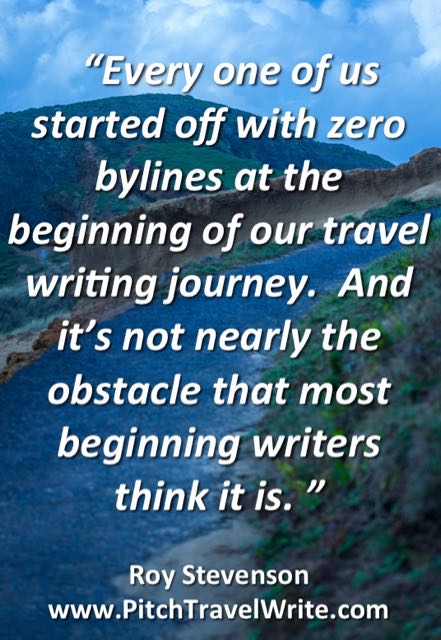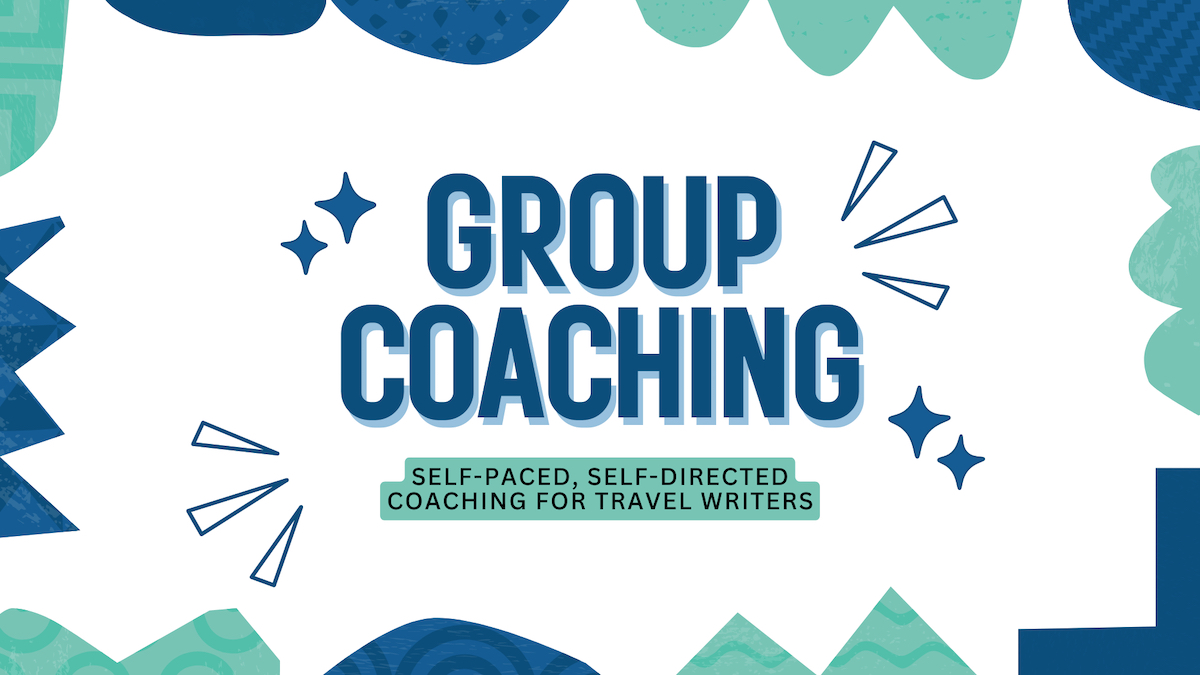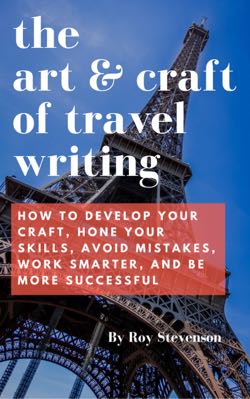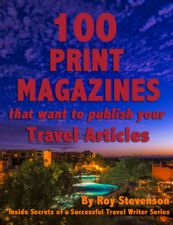Travel Writers Mistakes:
5 Errors That Will
Keep You From Success
By Roy Stevenson
There are several travel writers mistakes make that can cost you valuable time and reduce your productivity. Here are five blunders that can dramatically set back your progress toward getting your articles published.
Recognizing these mistakes is the first step to understanding what is holding up your progress. I also offer up some solutions to circumvent these situations and to help you get back on track.
Travel Writers Mistakes:
#1: Fretting over lack of bylines.
This is every beginner’s biggest worry: “how will an editor take me seriously if I don’t have any bylines?”
Every one of us started off with zero bylines at the beginning of our travel writing journey. And it’s not nearly the obstacle that most beginning writers think it is.
Like everyone else, I started off with zero bylines. Yet I managed to convince plenty of magazine editors that it was worth taking a chance on me. Within seven months I had 100 published articles!
Here are 3 pieces of advice for new writers, to overcome the barrier of “no bylines”:
1. Never admit that you don’t have any bylines.
2. Never fabricate bylines.
3. Write one heck of a good pitch.
Dream up exciting story ideas, create compelling query letters, and make sure your writing is devoid of spelling, grammar, and punctuation errors.
Simply present your dazzling pitch in your query letter. Don't mention anything about your absence of bylines.
If editors like your story idea, most will go for it anyway. Then, as you accumulate bylines, insert them into your query letters.
If you’re a beginning writer faced with “no bylines”, I wrote a separate article to help you deal with this.
And if writing a query letter has you stumped, I wrote an entire guide about query letters for travel writers, complete with 20 sample letters that you can use to build your own queries.
Travel Writers Mistakes:
#2: Getting distracted by peripheral travel writers activities.
Travel writing is a business, and along with a business come many peripheral activities: getting business cards, setting up a writer’s website, wondering whether you need a logo - the list goes on and on.
Some of these things become important as you get established. But only one thing is important at the beginning: getting bylines.
Your focus in your first few months of travel writing should be on dreaming up story ideas, sending out queries and writing articles. That’s all you should think about if you want to succeed.
Bylines are the single most important thing to work on when you’re getting started. They establish your credentials as a professional writer.
When I started writing, I knew it would be nice to have a writer’s website. But, I was always too busy writing articles to get one set up. It was only in my third year—after I had 250 articles published—that I finally managed to get my writer’s website online (www.roy-stevenson.com).
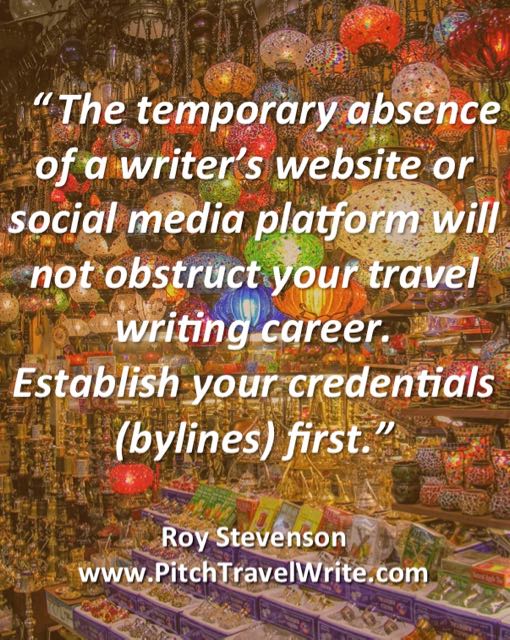
You might wonder if the absence of a writer’s website in my early years cost me writing assignments. Interestingly, I did experienced an uptick in my article acceptance rate after my writer’s website went ‘live’.
However, I believe this increase was more likely because I had accumulated so many bylines by then. I had established impeccable credentials with the editors and more assignments came my way.
In other words, my upsurge in published articles was because I was already a prolifically published writer. It was like a snowball that got bigger and bigger as it rolled downhill.
As I got published in more and more print outlets, I found more magazines magically opening up for me. Not having a writer’s website was not a barrier. I always had articles to write: often more than I could comfortably handle!
The temporary absence of a writer’s website or social media platform will not obstruct your travel writing career. Establish your credentials (i.e. bylines) first.
Don’t bother with a writer’s website until you’ve accumulated a solid body of bylines - at least a dozen or more published articles, in print and online. When you're ready to launch your writer's website, you can read my advice in this article.
Beyond a few basics like business cards and a writer’s website, another big distraction these days is “starting a blog”.
I’ve heard so-called ‘experts’ casually recommend that beginning writers set up a travel blog so that editors can see some of their handiwork. While this suggestion might seem like a good idea on the surface, I think it’s really bad advice.
Setting up a professional looking blog has the potential to take up so much of your time that you’ll never get any pitching and writing done.
A well-written blog with plenty of good content is a full-time job all by itself, especially if you decide to monetize it.
Spending time blogging distracts you from your main focus. Getting bylines in print media should be the novice travel writer’s prime directive.
This is one of the biggest travel writers mistakes. Many neophyte travel writers have disappeared down the travel blogging rabbit hole, to emerge years later, scratching their heads, wondering why they don’t seem to have accumulated any substantial print bylines.
(I wrote a separate article about starting a travel blog that will be helpful to read before you decide to start down this path.)
Beyond blogging, there’s other social media (Facebook, Twitter, etc.), the biggest potential time suck of them all.
A social media platform is important for writers to a certain degree. But I notice that many writers spend an inordinate amount of time reading and posting trivia. This is valuable time wasted. You're procrastinating when you hang out too frequently on social media.
My personal experience with social media is that it does not have the potential to reap you a significant number of print travel writing assignments. Magazine editors have far better things to do with their time than trawl Internet social media sites looking for writers. They prefer that writers approach them with good, old school pitches and query letters.
There’s nothing wrong with using social media for general exposure. Just don’t let social media divert your time attention from your main focus: pitching, traveling, and writing.
Travel Writers Mistakes
#3: Worrying over “what ifs?”
I’ve noticed one of the travel writers mistakes is worrying about things that probably will never happen. This is typical when you’re learning something new. But, worrying hampers you from getting on with your job of pitching and writing stories. It creates a mental roadblock that stops you from getting anything done.
Here are two of the most common examples of pointless fretting that I’ve seen:
1. “What if a magazine buys All Rights?”
2. “What if more than one editor wants to buy my story?”
To the first question, I can only say “so what?” Worse things can happen than an editor buying All Rights to your article.
And if more than one editor wants your story - it’s time to celebrate! You’re on to a good story idea. You can turn this into multiple sales with the right strategies.
Both these ‘problems’ are easy to deal with.
Freelancers need to get bold pretty quickly. Instead of letting the “what ifs” hamstring you, it’s time to forge ahead.
Don’t get bogged down with trivia and ‘what ifs’. Just fire out your query letters and deal with these situations if they happen. Most of them will not happen anyway.
Travel Writers Mistakes
#4: Giving up too soon
As a new travel writer, you’re eager to see your stories published. But I always recommend patience.
The best approach is to pitch your stories to print outlets first. Print gives you better credentials as a writer, and usually a paycheck to go with it. Later, if there are no takers, you can donate your story to a travel website.

Getting your travel articles published online is rarely an issue. It’s a
done deal. You would have to write an atrociously bad travel story to
have it rejected by a travel website.
Travel websites will take
almost every submission, because they are constantly looking for
editorial filler. And generally, they don’t pay.
I recommend you use
travel websites and blogs as a last resort for those articles you can’t
place in print.
Of all the travel writers mistakes, writing for websites is one of the biggest traps. Always pitch your stories to print media first.
Travel Writers Mistakes
#5: Putting off pitching until the last minute.
Another common travel writers mistake: waiting until just before you leave for a trip to begin pitching your story ideas to editors.
Waiting until the last minute to pitch your story ideas is a mistake because:
1) You’re unlikely to sell your story only a few days before your trip, and
2) Without confirmed assignments, you won’t be in a position to request travel comps.
Researching and pitching your travel story ideas needs to be done months in advance of your trip. The longer you delay, the less chance you have of getting your story accepted for publication. Editors prefer a long lead-time.
There are numerous advantages to pitching your stories and lining up assignments several months before you travel. This is the most costly of travel writers mistakes. Why? The important advantage to securing advance assignments is that you can use them to request comped accommodations, meals, and entry to tourist attractions.
Here are my guidelines for when to start pitching stories for a trip:
- For domestic trips in North America, line up your assignments 3-4 months before you travel. For example, if you’re planning a December cruise, you should pitch your story ideas in August/September.
- For international trips, line up your assignments 4-6 months before you plan to travel.
Lining up your assignments well in advance of the trip gives you time to send out plenty of queries and gives the editors time to respond.
It also gives you time to contact the relevant tourist agency and request assistance with comps, after you have one or two confirmed assignments.
Pitch your stories as soon as you start thinking about a trip - never wait until the last minute.
These are the most common travel writers mistakes I see. I've been coaching for several years now, and still I see beginning writers making the same errors. Keep these travel writing mistakes handy to remind yourself how to do it right, and you'll find your name in print more frequently - and see paychecks more, too.
There's no need to struggle with writing a query letter.
Here's a guide that tells you everything you need to know, along with 20 sample query letters that you can use as templates to help you write your own queries.
It's a steal at less than $20.
Related articles that will interest you:
Strategies for Dealing with Simultaneous Acceptances
5 Marketing Mistakes that Travel Writers Make
Pitch Travel Stories: My 5-Step Pitching Process from Start to Finish
5 Travel Writing Blunders and How to Avoid Them

Roy Stevenson is a professional travel writer and the author of www.PitchTravelWrite.com. Over the past ten years, he’s had more than 1000 articles published in 200 magazines, trade and specialty journals, in-flights, on-boards, blogs and websites and has traveled on assignment around the U.S. and to dozens of international destinations.
IF YOU ENJOYED THIS POST, GET UPDATES. IT'S FREE.
